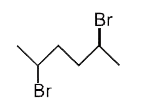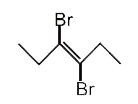Compound 'X' on heating with Zn dust gives compound 'Y' which on treatment with O3 followed by reaction with Zn dust gives propionaldehyde. The structure of 'X' is




The correct Answer is:C
To solve the problem step by step, we need to analyze the information provided about compound 'X', its reaction with zinc dust, and the subsequent reactions that lead to propionaldehyde.
Step 1: Identify the Reaction of Compound 'X' with Zinc Dust
When compound 'X' is heated with zinc dust, it produces compound 'Y'. This suggests that 'X' is likely a compound that can undergo reduction or dehydrohalogenation in the presence of zinc dust.
Hint: Think about what types of compounds can be reduced or dehydrohalogenated by zinc dust.
Step 2: Determine the Structure of Compound 'Y'
The problem states that compound 'Y' reacts with ozone (O3) followed by treatment with zinc dust to yield propionaldehyde (CH3CH2CHO). This indicates that 'Y' must be an unsaturated compound (likely an alkene or alkyne) that can undergo ozonolysis.
Hint: Consider the ozonolysis reaction and how it cleaves double or triple bonds to form carbonyl compounds.
Step 3: Analyze the Ozonolysis of Compound 'Y'
The ozonolysis of 'Y' will break it down into two carbonyl compounds. Since the final product is propionaldehyde, 'Y' must be a compound that, when ozonolyzed, gives propionaldehyde as one of the products.
Hint: Draw the structure of propionaldehyde and think about how it could be formed from a larger compound.
Step 4: Identify Possible Structures for Compound 'Y'
Given that propionaldehyde is produced, we can deduce that 'Y' could be a compound like 3-hexene (C6H12) or similar, which upon ozonolysis would yield propionaldehyde and another aldehyde or ketone.
Hint: Consider the carbon skeleton and how many carbons are needed to produce propionaldehyde.
Step 5: Determine the Structure of Compound 'X'
Since 'Y' is derived from 'X' through a reaction with zinc dust, we can hypothesize that 'X' is likely a dibromide or similar compound that can yield 'Y' upon reduction.
Hint: Look for a compound that has the potential to yield an alkene or alkyne upon reduction with zinc dust.
Conclusion
After analyzing the reactions and the structures, we can conclude that compound 'X' is likely to be a dibromide, specifically 1,2-dibromohexane. This compound, when treated with zinc dust, would yield 3-hexene (compound 'Y'), which upon ozonolysis and subsequent reduction would yield propionaldehyde.
Final Answer: The structure of compound 'X' is 1,2-dibromohexane.
When compound 'X' is heated with zinc dust, it produces compound 'Y'. This suggests that 'X' is likely a compound that can undergo reduction or dehydrohalogenation in the presence of zinc dust.
The problem states that compound 'Y' reacts with ozone (O3) followed by treatment with zinc dust to yield propionaldehyde (CH3CH2CHO). This indicates that 'Y' must be an unsaturated compound (likely an alkene or alkyne) that can undergo ozonolysis.
The ozonolysis of 'Y' will break it down into two carbonyl compounds. Since the final product is propionaldehyde, 'Y' must be a compound that, when ozonolyzed, gives propionaldehyde as one of the products.
Given that propionaldehyde is produced, we can deduce that 'Y' could be a compound like 3-hexene (C6H12) or similar, which upon ozonolysis would yield propionaldehyde and another aldehyde or ketone.
Since 'Y' is derived from 'X' through a reaction with zinc dust, we can hypothesize that 'X' is likely a dibromide or similar compound that can yield 'Y' upon reduction.
After analyzing the reactions and the structures, we can conclude that compound 'X' is likely to be a dibromide, specifically 1,2-dibromohexane. This compound, when treated with zinc dust, would yield 3-hexene (compound 'Y'), which upon ozonolysis and subsequent reduction would yield propionaldehyde.
Topper's Solved these Questions
- BOOK - KVPY PREVIOUS YEARCHAPTER - QUESTION PAPER 2013EXERCISE - PART-I ( CHEMISTRY)20videos
QUESTION PAPER 2013
- BOOK - KVPY PREVIOUS YEARCHAPTER - QUESTION PAPER 2013EXERCISE - PART-II ( CHEMISTRY)10videos
QUESTION PAPER 2013
- BOOK - KVPY PREVIOUS YEARCHAPTER - QUESTION PAPER 2013EXERCISE - PART-II ( CHEMISTRY)10videos
QUESTION PAPER 2013
- BOOK - KVPY PREVIOUS YEARCHAPTER - MOCK TEST 9EXERCISE - EXERCISE26videos
MOCK TEST 9
- BOOK - KVPY PREVIOUS YEARCHAPTER - QUESTION PAPER 2020EXERCISE - PART-II(CHEMISTRY)10videos
QUESTION PAPER 2020
Similar Questions
1,4-Pentadiene reacts with excess of HCl in the presence of benzoyl peroxide to give compound X, which upon reaction with excess of Mg in dry ether forms Y. Compound Y on treatment with ethyl acelate followed by treatment with dilute acid yields Z. Identify the structure of componds. X,Y and Z.
View SolutionAn organic compound C8H10 (A) on treatment with alkaline KMnO4 gives a compound C6H6O4. (B) which on strong heating gives C6H4O3 (C). The compound (D) in dry benzene in presen of AlCl3 gives compound (E). The compound (E) on treatment with PCl5 followed by reaction with H2/Pd,BaSO4 gives compound (F). Identify (A) to (F).
View Solution
Knowledge Check
- Question 1 - Select One
The compound which gives H2O2 on treatment with dilute acid is
APbO2BMnO2CTiO2DKO2 - Question 2 - Select One
Compound 'X' reacts with alcoholic KOH to yield compound ‘Y’ which on ozonolysis followed by reaction with ZnH2O gives methanal and propanal. Compound ‘X’ is
A1-propanolB1-butanolC1-chlorobutaneD1-chloropentane - Question 3 - Select One
Cyclohexane on ozonolysis followed by reaction with zinc dust and water gives compound E, on further treatment with aqueous KOH followed by heating yields compound F. The compound F is
A B
B C
C D
D
1,4-pentadiene reacts with excess of HCI in the presence of benzoyl peroxide to give compound X which upon reaction with excess of Mg in dry ether forms Y. Compound Y on treatment with ethyl acetate followed by dilute acid yields Z. Identify the structures of compound X,Y and Z.
View SolutionA ketone A which undergoes haloform reaction gives compound B on reduction. B on heating with sulphuric acid gives compound C, which forms mono-ozonide D. The compound D on hydrolysis in presence of zinc dust gives only acetaldehyde. Write the structures and IUPAC names of A, B and C. Write down the reactions involved.
View SolutionWhich of the following compound give methane on treatment with CH3MgI
View SolutionAn organic compound 'X' on treatment with acidified K2Cr2O7 gives a compound 'Y' which reacts with I2 and sodium carbonate to form Tridomethane. The compound 'X' is
View SolutionAn organic compound 'X' on treatment with acidified K2Cr2O1 gives a compound 'Y' which reacts with I2 and sodium carbonate to form triodomethane. The compound 'X' could be
View Solution

